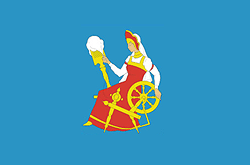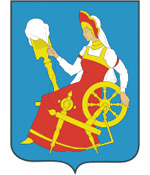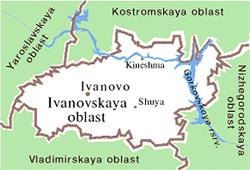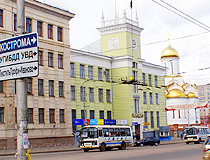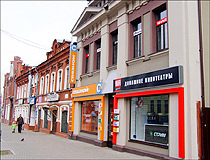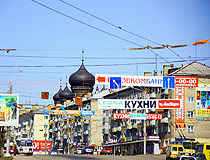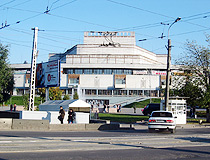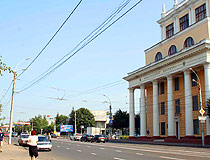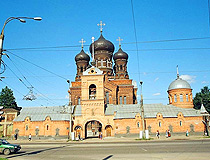History of Ivanovo
Foundation of Ivanovo
According to archaeological finds, the first people already lived on the territory of present Ivanovo more than 10 thousand years ago. In the 2nd half of the 1st and the beginning of the 2nd millenniums AD, the Finno-Ugric tribe of Merya lived in the northern, central, and western parts of Ivanovo Oblast. In the 9th-10th centuries, the mass migration of Slavs to these lands began, who eventually completely assimilated Merya.
Over time, these lands became part of the Vladimir-Suzdal Principality (1125-1389) - the core of the Russian state. Ivanovo arose as a settlement near the road from Rostov to Gorodets. Based on the results of archaeological excavations, it can be concluded that Ivanovo already existed in the 15th century. However, there is no exact date for the foundation of the settlement. The first documented written mention of Ivanov dates back to 1608, during the Time of Troubles in Russia.
According to the census of the early 1630s, the population of Ivanovo was 88 people. By 1667, the population grew by almost 10 times and amounted to 818 people. The natural and geographical reasons determined the commercial specialization of the region. Its severe climate and bad soil made farming risky, but there were convenient river routes and cheap technical raw materials (hemp, linen, wool, leather, etc.).
In the 17th century, when the southern and eastern regions of the country began to supply bread, the disadvantage of husbandry began to be felt even more sharply. The location of Ivanovo near important roads and waterways was especially favorable. At this time textile craft and trade reached a special development here.
More historical facts…
Ivanovo in the 18th-19th centuries
In the first half of the 18th century, Ivanovo had trade relations with Astrakhan, through which transactions were made with the East. At that time, Ivanovo was already a large settlement. It is proved by information about fires. So, in 1723, about 200 peasant houses burned down; in 1775 - 400 houses; in 1781 - 260 houses; in 1783 - 500 houses.
Trade in textiles brought great income to enterprising peasants. In the middle of the 18th century, they began to invest capital acquired in trade operations in industrial production. In 1742, Grigory Butrimov founded the first weaving factory in Ivanovo. In 1791, the first literacy school was opened in Ivanovo, where people learned to read in the Church Slavonic language and count. In 1795, 4,388 people lived here.
At the turn of the 18th-19th centuries, almost the entire population of Ivanovo was engaged in textiles. The French invasion of Russia (the Patriotic War of 1812) played a huge role in the industrial development of the village. The fire destroyed most of the large enterprises in Moscow, as a result of which demand and prices for textiles increased, and local factories, not meeting the competition, began to increase their textile production even faster. Central Asia and Persia were also one of the most important markets.
In 1845, a post office was opened in Ivanovo. Since the middle of the 19th century, the local textile industry began to develop in the conditions of constant supply risks. Raw materials, fuel, dyes were being brought from remote areas of the Russian Empire and from abroad (cotton - from the USA, Egypt, and Turkestan, fuel - from Baku and Donbass, most of the artificial dyes - from Germany).
Large enterprises preferred American cotton, which was of high quality. In the first half of the 1860s, as a result of the crisis caused by the US Civil War, the supply of American cotton to Europe fell sharply. Soon, local industry began to use mainly Turkestan cotton. In the second half of the 19th century, there were several dozen enterprises in Ivanovo, but about 15 of the largest and most developed cotton mills determined its industrial potential.
In 1871, the neighboring villages of Ivanovo and Voznesensky Posad were transformed into the town of Ivanovo-Voznesensk. This year is considered the year of foundation of Ivanovo. From the middle of the 19th century, Ivanovo was also known under such unofficial names as “chintz kingdom” and “Russian Manchester” (Manchester in England was known worldwide for its textile industry). In 1897, the population of the town was about 54,200 people.
Ivanovo in the first decades of the 20th century
In the late 19th - early 20th centuries, the entire Russian Empire was the market for cheap Ivanovo-Voznesensk chintz. By 1914, the population of Ivanovo increased to 146 thousand. Ivanovo-Voznesensk became the leading textile center of the Russian Empire. About 50 textile enterprises and factories operated in the city.
In 1914, with the outbreak of World War I, production in Ivanovo-Voznesensk fell sharply. The decline in production amounted to 12%, in 1916 - 23%. A more significant recession was avoided thanks to military orders.
During the Russian Civil War, Ivanovo-Voznesensk was in the deep rear of Soviet Russia. Factories worked intermittently or even stopped. The outflow of the population to the villages began. The number of inhabitants decreased also due to conscription. The nationalization of enterprises, austerity of resources, and other measures of the authorities, suspended this process. Enterprises began to resume their work in the early 1920s. In 1923, the population of Ivanovo was only about 71,800 people, half as much as a decade ago.
In 1918, the first higher educational institutions of the city were founded: Ivanovo-Voznesensky Polytechnic Institute, then Ivanovo-Voznesensky Pedagogical Institute. In 1930, the Polytechnic Institute was divided into four universities: energy, agricultural, chemical-technological, and textile.
In the 1920s, Ivanovo-Voznesensk played the role of a kind of proving ground where a Soviet social experiment was conducted to build a new socialist society. The city was the center of creativity of avant-garde architects (especially Constructivists), who embodied the ideals of this society.
In 1922-1925, a city water supply system was built. In 1926, public bus transport started operating. In 1934, tram traffic was opened. In the 1930s, a civilian airport and a new military airfield were built, a new building of the railway station was constructed in the constructivist style. In 1925-1926, production volumes reached the pre-war level, after which the construction of new enterprises began.
In 1929, the consolidation of regions and their transformation into oblasts took place in the USSR. Vladimir, Ivanovo-Voznesensk, Kostroma and Yaroslavl governortates were merged into Ivanovo Industrial Oblast, which lasted until 1936. Ivanovo-Voznesensk became its center and in the propaganda of that time was called the “Red Manchester” and the “third proletarian capital of the USSR.” During this period, a significant part of the cultural heritage of the city was lost. In the 1920s and 1930s, most of the churches were demolished.
December 27, 1932, Ivanovo-Voznesensk was renamed Ivanovo. In 1939, the population of the city was 285,182 people.
Ivanovo during the Second World War and beyond
At the end of 1942, during World War II, the battle history of the French Normandie-Niemen fighter squadron, which consisted of pilots sent to the USSR by Free France, began in Ivanovo. Ivanovo played an important role in supplying the Red Army with textiles, as a lot of the country’s textile enterprises ended up in the occupied territory, and in addition, the factories in Leningrad stopped operating. In total, during the war years, about 70 thousand residents of Ivanovo were drafted into the army, 27 thousand of them were killed or gone missing.
In 1951, the first general plan of Ivanovo was approved. In 1955, the process of gasification of the city began. In 1962, a trolleybus network was created. In the 1950s and 1960s, the textile industry of the city developed dynamically. In 1967, the population was about 407,000 people.
In the post-war period, the issue of the ratio of male and female population arose sharply: the latter was much larger even before the war, since then women were mainly employed at textile enterprises, and after the war this imbalance only intensified. This imbalance was also the reason why Ivanovo became known in the USSR as the “city of brides”. Ivanovo was included in the Golden Ring of Russia tourist route. In 1989, the population of Ivanovo was 478,370 people.
During the transition of Russia to a market economy, the industry of the city entered a period of crisis. Problems began during perestroika, but after the collapse of the USSR, the situation became even more difficult. Economic ties with the cotton-supplying Central Asian republics were cut off. Enterprises switched to the production of the cheapest fabrics.
The campaign for the return of historical names that began after the collapse of the USSR practically didn’t affect Ivanovo. But since the beginning of the 1990s, the question has periodically been raised about returning the name Ivanovo-Voznesensk to the city. Surveys show that the majority of Ivanovans oppose this.
In 1996, a new coat of arms of Ivanovo was adopted. The figure of a woman engaged in spinning symbolizes the emergence of textile production in Ivanovo. At the beginning of the 21st century, some industries, for example, the clothing industry, wholesale and retail trade in textiles, began to develop again.
Pictures of Ivanovo
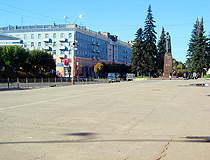
Lenin Square in Ivanovo
Author: Sasha Petelina
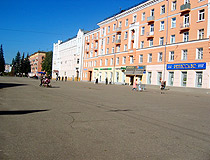
Lenin Square in Ivanovo
Author: Sasha Petelina
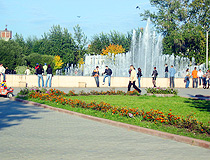
Fountain in Ivanovo
Author: Sasha Petelina
Ivanovo - Features
The city of Ivanovo is located in the center of Ivanovo Oblast on the banks of the Uvod River, about 100 km from Yaroslavl, Vladimir, and Kostroma. Unlike these neighboring cities, Ivanovo developed primarily as an industrial center with a significant number of industrial enterprises. The City Day is celebrated at the end of May.
The climate is temperate continental. Summer is warm, but not hot; winter is moderately frosty with permanent snow cover. The coldest month of winter is January with an average monthly temperature of minus 12 degrees Celsius, the warmest month of summer is July, which average monthly temperature is plus 18.8 degrees Celsius.
Public transport in Ivanovo is represented mainly by mini-buses. In addition, the city has a network of trolleybus routes. There are 7 universities in the city: polytechnic, chemical-technological, energy, Ivanovo State University, medical, agricultural, and fire rescue academies.
In the northern part of the city there is the Ivanovo Northern Railway Station, which is a large railway junction. The first railway station was built in 1894. In 1934, a new, more spacious train station was built next to it, which to this day is the largest architectural monument of modernism in Russia. There are regular daily trains to Moscow and St. Petersburg.
Ivanovo is traditionally considered the center of the textile industry in Russia. At the moment, the number of textile enterprises has slightly decreased compared to the times of the USSR, but there are a lot of sewing enterprises. Today, food industry enterprises are developing, as well as trade and services. Also there are several chemical enterprises in the city.
Ivanovo, the center of light industry, received an unofficial name the “city of brides”, since a large number of women worked at its fabric manufacturing and processing enterprises. Andrei Mironov’s song “Well, why are we not a couple”, sounded in the Soviet movie “Honest, Intelligent, Unmarried” (1981), also played a certain role in the popularization of this expression. In each of its three verses there are such lines:
I tell you about my love again and again,
But when I will be tired of it,
You should know that I’ll go to Ivanovo,
And Ivanovo is a city of brides.
Ivanovo is one of the historical and cultural centers of the country located in the center of the famous tourist route known as the Golden Ring of Russia. The city has a number of different museums, 8 pilgrimage tourism sites, and about 400 historical and architectural monuments.
In the 1920s-1930s, the city experienced its heyday, due to its reputation as a revolutionary and proletarian city. In the number of architectural monuments of those years it is second only to Moscow in the Central Federal District. The architecture of the avant-garde is widely represented here (including constructivism), which includes about 50 buildings. Also, there are several almost completely preserved pre-revolutionary textile factories, which may be of interest to those interested in industrial design.
Main Attractions of Ivanovo
Museum of Industry and Art. The three-story building of the museum was constructed in the neoclassical style of the “Italian palazzo” in 1914. The natural-scientific exposition of the museum is dedicated to the flora and fauna of Ivanovo Oblast. You can also see an exposition of cold steel and firearms of the 14th-20th centuries, numismatic and faleristic collections, church utensils, and personal belongings of the Emir of Bukhara Alim Khan. Baturina Street, 6/40.
Museum of Ivanovo Chintz - one of the most visited museums of the city. A unique collection of textiles totals more than 500 thousand exhibits. The main exhibition “Ivanovo Textiles. History and Present” is dedicated to the development of the textile industry in the city. Ivanovo chintz is exhibited as one of the types of decorative art. There are expositions with equipment for the production of fabric, textile examples including fabric propaganda posters of the Soviet period. Baturina Street, 11/42.
Ivanovo Regional Art Museum. This museum has graphic works and paintings, sculptures, photographs, etc. The expositions are devoted to the art of the Ancient World (Egypt, Greece, Rome), decorative and applied art of the East (India, China, Persia, Iran), the Russian art of the 18th-20th centuries. There is also an exhibition of icons of the 15th-20th centuries. Lenina Avenue, 33.
Museum of the Soviet Automobile Industry. Here you can see a unique collection dedicated to the automotive industry of the USSR. The exhibition has cars of all major Soviet auto brands: “Volga”, “Chaika”, “ZIL”, “GAZ”. There are not only mass produced models, but also rather rare cars produced in very limited quantities. You can also buy thematic souvenirs here: collectible models of Soviet cars, books, mugs, posters, calendars, t-shirts, etc. Parizhskoy Kommuny Street, 16.
Shchudrovskaya Tent - the oldest of the surviving brick buildings in Ivanovo, a monument of architecture of federal significance. One of the symbols of the city, it is considered a unique example of civil stone architecture of the 17th century, which has no analogues in neighboring regions. 10 Avgusta Street, 36?.
Dyuringer’s Manor (1914) - one of the few surviving pre-revolutionary estates in Ivanovo built in the Art Nouveau style. Marii Ryabininoy Street, 33.
The House-Ship (1930) - a monument of constructivism of federal significance and one of the most unusual residential buildings in Ivanovo. This building resembles a sea ship. Lenina Avenue, 49.
Transfiguration Cathedral (1893) - one of the most beautiful churches in Ivanovo built in the style of old Russian architecture of the 17th century. Kolotilova Street, 44.
The Holy Vvedensky Convent - one of the Orthodox shrines of Ivanovo located in the heart of the city. The church in honor of the Introduction of the Virgin, the main part of the convent, is an architectural monument of the early 20th century. Bazisnaya Street, 23.
Ivanovo also has a drama theater, a philharmonic society, a circus, a zoo, several parks, a promenade, and a large number of monuments and memorials.


